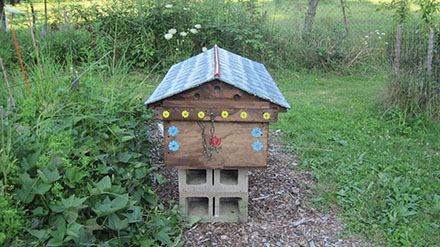
New Hive Type
I am 75 years old and beekeeping work is getting more difficult due to the weight of the boxes. I decided to make this new type of hive after reading your magazine. I am sending you a picture. I made the walls double thick because of our weather. Bees seem happy. …will let you know.
Richard Botamer
Hobbyist Queens
Article in September 2018
Great article showing an interesting alternative application to Dr. Snelgrove’s technique written in 1934, titled Swarming – Its Control and Prevention.
Sincerely,
Robert Lamothe
‘High-yield’ Farming Could Help Spare Habitats and Reduce Environmental Impacts
So intensive farmers would be allowed to devastate their land and their water but no one else’s? Well, IF you can keep them from harming the water / air / soil of their immediate neighbors and IF you can curb GREED in humans who are desperate to make as much profit as they can, you might have something. Realize that this was the argument for large CAFOs (concentrated animal feeding operations) to start with.
How would you institute rules and laws to prevent farmers from having too much land that gets mistreated? How could you say to the residents of a county: Nope, you can’t do what you want with your land, and if you do, we will revoke your permits and put you out of business.
Interesting idea, just not practical or well thought out.
Cécile Stelzer-Johnson
“Swiffer” Tip
Dear Ms. Traynor,
First, I’d like to tell you how much I enjoy your magazine; each month I devour it cover to cover. Secondly, I wanted to pass on a little trick we use down here. We use “Swiffer” pads cut in half laid across the back of the brood box to trap small hive beetles. We set them in sweeping side up. The SHB get caught in the fibers and give us an idea as to the level of infestation.
Lastly, I enjoyed the article on the Long Hive boxes and would like to know if there is a commercial provider for the hinged top boxes like the ones highlighted in your article. For someone like me, this seems a great chance for a hobbyist beekeeper.
Again thank you for a fine magazine. Keep up the great work and fascinating articles.
Regards
Geoffrey Yamaucai
Dear Geoffrey,
Most people make their own long hives using materials available at the local hardware and lumber store. The author has the plans available on her website https://www.abbottsustainablefarms.com/long-langstroth-hive. I’ve mailed you a copy of the plans, so you have them. There are a number of vendors who sell premade long hives, but they tend to be expensive, starting at around $350.
Best,
Kirsten
Apisoir
Dear Dr. Traynor
My name is Michael Alberty, and I am a wine writer based in Portland, Oregon.
My wine background means terroir is an important part of my life. After reading Rowan Jacobson’s book “American Terroir: Savoring the Flavors of Our Woods, Waters, and Fields,” I became obsessed with how it relates to my other passion, honey. I also noticed sea salt and oyster mavens staking out territory with the word “merroir.” I thought, “Why shouldn’t honey have its own word for terroir?” After a bit of reflection, I came up with “apisoir.”
To get the ball rolling, I created a Wikipedia page. Within hours the page was deleted by a crusty old English Wiki editor who called it a hoax and threatened to ban me from his kingdom if I persisted. His claim that apisoir wasn’t a word led me to ask how he thought words started? He said he ….


